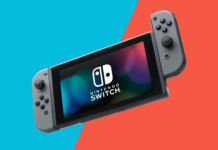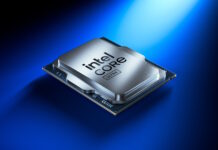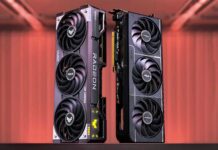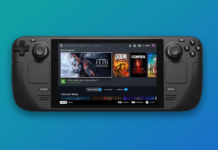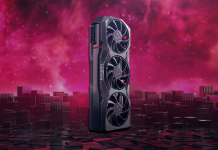Sapphire Atlantis Radeon 9800 Pro |
Sapphire Atlantis Radeon 9800 Pro

|
Chip: |
R350
|
Manufacturing process: |
0.15-micron
|
Transistors: |
~125 mil.
|
Core clock speed: |
380 MHz
|
Memory clock speed: |
|
Pixel Shader: |
2.0
|
Vertex Shader: |
2.0
|
Pixel
Pipelines/Pixel Fillrate: |
8
/ 3040 MP/s
|
TMU’s/Texel Fillrate: |
1
/ 3040 MT/s
|
RAMDAC: |
(2) 400 MHz
|
Amount of memory: |
128 MB
|
Type of memory and interface: |
256-bit, DDR-SDRAM
|
In- and outputs: |
VGA, DVI-I, S-Video Out
|
Extra
peripherals: |
S-video
and composite cables, DVI-VGA dapater, S-Video-Composite adapter
|
Software: |
Redline
tweaker tool and drivers
|
Full version applications: |
PowerDVD
XP, Soldier of Rortune II and Retrun to Castle Wolfenstein
|
Estimated price: |
|
Sapphires specifications
and board layout etc. are identical to ATi’s.

Front |
|

Back |
|
As for design
and cooling Sapphire stuck with ATi’s reference design. That is at least on
the board they sent to us. They also have another version with a different
fan but since we didn’t recieve that board we can’t give it a grade either.
The board we have today uses the standard ATi cooling which is a low noise
fan that cools the card sufficiently. Nothing special but it does the job
as it’s supposed to.
|
Design/Cooling
|
We
take a look at the functional and aesthetical design. The performance
and sound level of the cooling is also very important. |
|
Here we have
the accessories. Apart from the normal cables and drivers CD Sapphire bundle
their own overclocking and tweaking utility called Redline. This utility is
based on Rage3D Tweak, to be honest Rage3D Tweak is a better tool since it’s
updated more regularly. Other than the UI and the fact that Sapphire don’t
update it as often the two applications have identical functionality as far
as I can see. Of course it is a very nice move of Sapphire to bundle it. Especially
for "Avarage Joe" who isn’t likely to come in contact with Rage3D
Tweak.
 Peripherals
Peripherals |
|
 Software
Software |
|
The bundled software
is a nice package. Both SOFII and RTCW are good games even though they are
a bit old by now. PowerDVD XP is one of the nicest DVD-players out there and
the Redline utility is pretty unique as far sa bundled software goes.
|
Accessories/Features
|
We
look at the amount and usefulness of included accessories and integrated
features. |
|
When it comes
to features the one thing that we constantly keep missing on ATi’s high end
boards is ViVo-functionality. This commentis general for all boards though
and nothing specific for Sapphire.
Hercules 3D Prophet 9800 Pro |
Hercules 3D Prophet 9800 Pro

|
Chip: |
R350 |
Manufacturing
process: |
0.15-micron |
Transistors: |
~125 mil. |
Core
clock speed: |
380 MHz |
Memory
clock speed: |
|
Pixel Shader: |
2.0
|
Vertex Shader: |
2.0
|
Pixel Pipelines/Pixel Fillrate: |
8
/ 3040 MP/s
|
TMU’s/Texel Fillrate: |
1
/ 3040 MT/s
|
RAMDAC: |
(2) 400 MHz |
Amount
of memory: |
128 MB |
Type
of memory and interface: |
256-bit, DDR-SDRAM |
In-
and outputs: |
VGA, DVI-I, S-Video Out |
Extra
peripherals: |
S-video
and composite cables, DVI-VGA dapater, S-Video-Composite adapter
|
Software: |
3Deep,
ATi tech demos, drivers and much more |
Full
version applications: |
PowerDVD
XP, Raven Shield Rainbow Six 3 |
Estimated
price: |
|
Hercules has
the only PCB that really differs from ATis reference design. Though upon closer
inspection we can see that color is really the only differential factor here.
Every other aspect of the PCB seems identical when it comes to layout etc.
Perhaps a few components such as capacitors etc. are of another type than
those used on the other boards.

Front |
|

Back |
|
The nice thing
about Hercules board is their cooling. They fitted the memory and the core
with copper heatsinks. According to Hercules this will provide better cooling
and it should also be more silent than the reference fan. Personally I didn’t
find that it was more silent than the reference fan but the heatsinks etc.
should bring better cooling. The fan is also fitted with a blue LED which
provides a cool blue light.
|
Design/Cooling
|
We
takes a look at the functional and aesthetical design. The performance
and sound level of the cooling is also very important. |
|
 Software and accessories
Software and accessories |
|
Hercules software
and driver CD contains loads of applications such as 3Deep and even some demos
from ATi. The latest incarnation of Tom Clancy’s Rainbox Six is bundled with
the board. It’s refreshing to see that a manufacturer chose to bundle a fairly
new and hot game for once. For DVD playback they go the standard route and
bundle PowerDVD XP. All needed cables and converters are also included.
|
Accessories/Features
|
We
look at the amount and usefulness of included accessories and integrated
features. |
|
When it comes
to price Hercules is more expensive than the other boards. Personally I don’t
feel that a blue LED or memory heatsinks warrant this difference at all. But
then again I don’t really care about cosmetics.
Connect3D Radeon 9800 Pro |
Connect3D Radeon 9800 Pro

|
Chip: |
R350 |
Manufacturing
process: |
0.15-micron |
Transistors: |
~125 mil. |
Core
clock speed: |
380 MHz |
Memory
clock speed: |
|
Pixel Shader: |
2.0
|
Vertex Shader: |
2.0
|
Pixel Pipelines/Pixel Fillrate: |
8
/ 3040 MP/s
|
TMU’s/Texel Fillrate: |
1
/ 3040 MT/s
|
RAMDAC: |
(2) 400 MHz |
Amount
of memory: |
128 MB |
Type
of memory and interface: |
256-bit, DDR-SDRAM |
In-
and outputs: |
VGA, DVI-I, S-Video Out |
Extra
peripherals: |
S-video
and composite cables, DVI-VGA dapater, S-Video-Composite adapter
|
Software: |
Drivers |
Full
version applications: |
– |
Estimated
price: |
|
Once again,
both specifications and board layout is indentical to ATis reference design.
A bit boring isn’t it?

Front |
|

Back |
|
|
Design/Cooling
|
We
takes a look at the functional and aesthetical design. The performance
and sound level of the cooling is also very important. |
|
Connect3D has
a rather "light weight" bundle. They simply bundle the drivers and
cables. No games, no extra software etc.
 Software and accessories
Software and accessories |
|
This is a pretty
boring package. However Connect3D is a budget brand so we didn’t expect much
either. Problem is that there’s nothing "budget" about the price
when compared to HIS and Sapphire.
|
Accessories/Features
|
We
look at the amount and usefulness of included accessories and integrated
features. |
|
HIS Excalibur Radeon 9800 Pro |
HIS Excalibur Radeon 9800 Pro

|
Chip: |
R350 |
Manufacturing
process: |
0.15-micron |
Transistors: |
~125 mil. |
Core
clock speed: |
380 MHz |
Memory
clock speed: |
|
Pixel Shader: |
2.0
|
Vertex Shader: |
2.0
|
Pixel Pipelines/Pixel Fillrate: |
8
/ 3040 MP/s
|
TMU’s/Texel Fillrate: |
1
/ 3040 MT/s
|
RAMDAC: |
(2) 400 MHz |
Amount
of memory: |
128 MB |
Type
of memory and interface: |
256-bit, DDR-SDRAM |
In-
and outputs: |
VGA, DVI-I, S-Video Out |
Extra
peripherals: |
S-video
and cable, DVI-VGA dapater, S-Video-Composite adapter
|
Software: |
Drivers,
6 in 1 "Lite" Game CD |
Full
version applications: |
PowerDVD
XP, PowerDirector, Duke Nukem Manhattan Project |
Estimated
price: |
|
HIS board didn’t
arrive until a few hours before I published this article. Thus I didn’t have
the time to take any photos of the board or package. I will however update
this article with pictures of HIS product within a couple of days.

Front |
|
I can also let
you know that HIS have some very cool looking cooling called IceQ on the way.
We’ll be taking a look at that as soon as possible. (You can find a sneek
preview from CeBIT here.)
|
Design/Cooling
|
We
takes a look at the functional and aesthetical design. The performance
and sound level of the cooling is also very important. |
|
HIS has a nice
package when it comes to software. PowerDVD XP for DVD playback and PowerDirector
for video editing. The game Duke Nukem Manhattan Project is also included,
but is perhaps not the hottest game around. The 6 in 1 "Lite" Game
CD is a nice treat. It would have been nice if they bundled a composite cable
too though.
|
Accessories/Features
|
We
look at the amount and usefulness of included accessories and integrated
features. |
|
Both HIS and Sapphires
board go for 4300 SEK which is in my opinion a reasonable price for such high
end boards.
PowerColor Radeon 9800 Pro |
PowerColor Radeon 9800 Pro

|
Chip: |
R350 |
Manufacturing
process: |
0.15-micron |
Transistors: |
~125 mil. |
Core
clock speed: |
400 MHz |
Memory
clock speed: |
|
Pixel Shader: |
2.0
|
Vertex Shader: |
2.0
|
Pixel Pipelines/Pixel Fillrate: |
8
/ 3200 MP/s
|
TMU’s/Texel Fillrate: |
1
/ 3200 MT/s
|
RAMDAC: |
(2) 400 MHz |
Amount
of memory: |
128 MB |
Type
of memory and interface: |
256-bit, DDR-SDRAM |
In-
and outputs: |
VGA, DVI-I, S-Video Out |
Extra
peripherals: |
S-video
and composite cables, DVI-VGA dapater, S-Video-Composite adapter
|
Software: |
Drivers,
5 in 1 "Lite" Game CD |
Full
version applications: |
WinDVD
4, Commanche 4 and Summoner |
Recommended
price: |
|
Wow. Here’s
the first board which has a bit different specifications. Apparently PowerColor
didn’t think that ATi’s reference core speed of 380 Mhz was enough, instead
they opted for 400 MHz. They even clocked the memory higher, 760 MHz instead
of 680. Not bad! This is the type of thing that we’d like to see more often.
 Front
Front |
|
 Back
Back |
|
Yet again the
reference design..
|
Design/Cooling
|
We
takes a look at the functional and aesthetical design. The performance
and sound level of the cooling is also very important. |
|
The Hynix memory
on the PowerCcolor board is rated 2.2 ns which is 910 MHz. 760 MHz isn’t even
close to that and from what we’ve gathered this is due to the memory being
under voltaged. A volt mod on this baby might do wonders in other words! Of
course the PCB tracing etc. might not handle much higher clock speeds.
 Software and accessories
Software and accessories |
|
PowerColor skipped
using PowerDVD XP and decided to go for WinDVD instead. Fine by me as both
applications are very good. The two full version games, Commanche 4 and Summoner,
are pretty nice. And PC also added a demo CD with the following game demos
on it: Ballistics, Black Hawk Down, Ghost Recon, Serious Sam The Second Encounter
and Viectcong. All of them, with the exception of Ballistics, are very nice
games and will keep you occupied for a couple of hours.
|
Accessories/Features
|
We
look at the amount and usefulness of included accessories and integrated
features. |
|
This board has
a recommended price of 499 US dollars, while a bit more than the other boards
the performance nearly compensates for the extra cash. And of course street
price is likely to be somewhat lower than the recommended price.
|
Test setup
|
|
Hardware
|
| Processor: |
AMD Athlon XP 2600+ (333) Mhz
|
| Mainboard: |
Soltek
SL-75FRN-L (nForce2)
|
| RAM: |
768 MB DDR333 @ 2-5-2-2 Timings:
2x 256 MB Corsair TWINX512-3200LL DDR-SDRAM
256 MB PC3200 OCZ PC3200 Rev2 DDR-SDRAM
|
|
Videocards:
|
ATi Radeon 9700 Pro (128 MB, 325/620)
ATi Radeon 9800 Pro (128 MB, 380/680)
ATi Radeon 9800 Pro (256 MB, 380/700)
Connect3D Radeon 9800 Pro (128 MB, 380/680)
Hercules Radeon 9800 Pro (128 MB, 380/680)
HIS Excalibur Radeon 9800 Pro (128 MB, 380/680)
PowerColor Radeon 9800 Pro (128 MB, 400/760)
Sapphire Atlantis Radeon 9800 Pro (128 MB, 380/680)
nVidia GeForce FX 5800 Ultra (128 MB, 500/1000)
|
|
HDD:
|
80 GB Western Digital Caviar 7200 RPM Special Edition (8 MB cache)
|
|
Soundcard:
|
Creative
Soundblaster Audigy 2
|
|
Ethernet:
|
D-Link DFE-530TX 10/100
|
|
Software
|
| Operating system: |
Windows XP Professional (Service Pack 1)
|
| Video drivers: |
nVidia: Detonator FX 44.03
ATi: Catalyst 3.4 6343 |
| Other drivers: |
nVidia UDA Chipset Drivers v2.42
|
|
Benchmarks:
|
3DMark2001
SE b330
3DMark03 b330
Quake 3 1.32
UT2003 v2255
|
I decided not
to run many tests in this roundup since basically all we are after is the
difference between the 9800 Pro boards. We’ve already covered the 9700 vs
9800 vs 5800 in previous review/previews and thus we will not go very in depth
today. Since Futuremark has done something about the "driver irregularities"
with their new patch we can now use it for the first time to compare the FX
board to the Radeon boards.
For all tests
I used nVidias Quality setting and ATis Quality setting. All benchmarks are
thus run with full trilinear filtering, even when testing anisotropic filtering.
I have some reservations
when it comes to the Radeon 9800 Pro 256 MB scores. The card simply wouldn’t
outperform the other boards except in two rare cases which you’ll notice.
I’ve asked ATi about it and they basically said not to expect a difference
unless frame buffer memory runs out. (Which it does in the two tests I’ll
show you later on.)
While I’m at
it I might as well comment Image Quality here. As far as I can tell there
is absolutely no difference between any of the 9800 Pro boards at all. They
all have very high quality in 3D, 2D and TV-out. Especially FSAA as most of
you already know is simply amazing on ATis R3X0 series. Thus all boards recieve
the same grade here:
|
Image
quality
|
|
The
image quality in 2D as well as in 3D are measured. In 3D the quality
of FSAA and Aniso is important. The quality of the TV-out and any other
in and outputs are compared.
|
|
Let’s start
off with the 3DMark benches.
In 3DMark2001
we would really need a faster processor to see any differences here. Apparently
PowerColors higher clockspeeds are in full effect and it takes the lead
by 400 points. 9700 Pro and 5800 Ultra are tied for the last positions.
Radeon 9800 Pro 256 MB doesn’t really show any advantage over the 128 MB
boards here simply because 3DMark2001 doesn’t consume enough memory.
3DMark03
is a different story alltogether. After applying the new 330 patch the
FX board dropped cold. It’s down from 58xx to 41xx, a loss of over 1500
marks. In all fairness ATis scores has also dropped somewhat, I got a
59xx score with the PowerColor board before applying the patch. The 256
MB ATi board has a slight advantage in this test. This basically only
due to an advantage in Game Test 4 Mother Nature which requires loads
of VRAM.
GeForce FX
5800 Ultra rules the first set of Quake 3 benchies. I’ve seen it over and
over again. In most, especially Q3 based, games, the nVidia boards perform
better under the heavily CPU limited tests. I would expect that this is
simply due to the drivers.
Things start
to get interesting when we turn on FSAA and Aniso. At 1024×768 with 2xAA
and 4xAF the 9800 boards are faster, again with PowerColor taking the
lead, though with a small margin. As we crank up the resolution the FX
5800 Ultra gets the upper hand though closely trailed by PowerColors board.
The other boards are not far away though and even Radeon 9700 pro manages
to compete very well here.
All boards
managed 2xAA/4xAF with flying colors, now how about doubling those settings?
The FX 5800 Ultra is now knocked down to the last place and even 9700
Pro is a bit faster. PowerColor starts to strech its legs here. 4xFSAA
and 8x ANiso isn’t enough to push any of the Radeon boards below 100 fps,
let’s see if we can manage to do that with 6x FSAA and 16x Aniso (8x AA/8xAF
on the FX board).
The ATi based
board have the FX board for lunch here, it simply won’t perform well using
any FSAA mode over 4x. (Which is due to the fact that it doesn’t support
more than 4 MSAA samples per pixel and thus it has to add SSAA which of
course is a lot slower.) PowerColors board is of course still in the lead
and as we can see not even 1600×1200 with 6x FSAA is enough to tax the
128 MB memory and thus the 256 MB board from ATi fails to shine. Extra
points to PowerColor for passing 1600×1200 MaxAA/MaxAF without dropping
below 100 fps. 🙂
In case you are wondering why the FX board isn’t in the 1600×1200 test
it’s simply because it runs out of VRAM.


